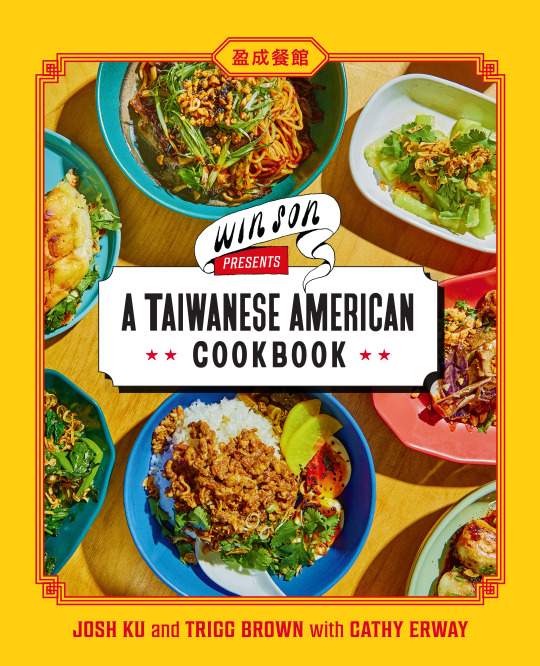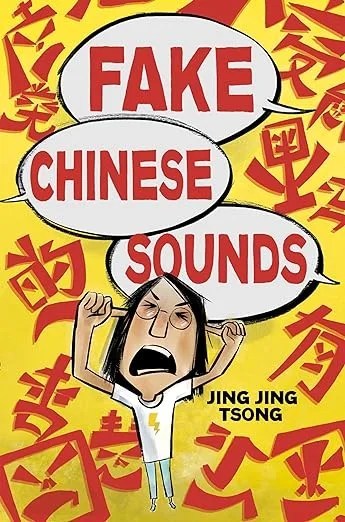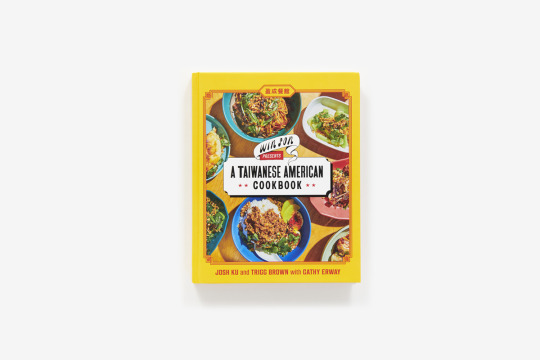#taiwanese american
Photo

RECIPE: Lamb Wontons (from Win Son Presents A Taiwanese American Cookbook by Josh Ku, Trigg Brown and Cathy Erway)
One time Trigg’s friend Julia Sung was in the kitchen at Win Son and she shared this game her family plays every Lunar New Year. They make wontons and stash a whole peanut inside one wonton. The person who finds the wonton with the peanut gets an extra fat hongbao, or red envelope stuffed with money. The catch? If you accidentally eat the peanut, you get nothing.
We once held this contest in our restaurant where we put a peanut in one of our wontons and would buy the dinner for the winning customer. It’s tricky, though, since people have peanut allergies, so we had to warn everyone who ordered wontons and anyone with the allergy was obviously disqualified. We forget who won, but it was hilarious.
Though wontons are most commonly filled with pork, or a combo of pork and shrimp, these are made with an unconventional lamb filling, which is spiced up with cumin and coriander. It’s served on a bed of labneh and you can add chili oil at your own discretion. This makes for a fun twist on a familiar dish that never gets old.
INGREDIENTS
1 pound (455 g) ground lamb
1 tablespoon grated fresh ginger
1 tablespoon grated garlic
2 teaspoons red chile flakes, such as gochugaru or Sichuan chile flakes
½ teaspoon salt
1 teaspoon toasted white sesame seeds
1 teaspoon toasted sesame oil
1 tablespoon light soy sauce
2 teaspoons rice wine, preferably Taiwanese, or use Shaoxing rice wine as a substitute
1 heaping cup (45 g) packed flat chives or 4 large scallions, chopped
1 pack square yellow wonton wrappers (about 50)
2 teaspoons cumin seeds, for dusting (optional)
1 cup (240 ml) labneh
1 cup (240 ml) Sweet Soy Dipping Sauce (as featured in the book)
House Chili Oil (as featured in the book) or your favorite chili oil, such as Lao Gan Ma Spicy Chili Crisp (optional)
1 cup (16 g) chopped fresh cilantro leaves and tender stems (optional)
2 teaspoons “Lamb” Spice Mix (as featured in the book)
Fold together the lamb, ginger, garlic, chile flakes, salt, sesame seeds, sesame oil, soy sauce, rice wine, and chives (do not overmix). Marinate in the refrigerator overnight, or for up to 2 days.
To make a wonton, place a wrapper in a diamond shape on your palm. Place about 1 teaspoon of the filling horizontally along the lower half of a wrapper. Dip your finger in water and trace the sides of the wrapper to wet it; wet a line just above the center of the wrapper. Fold the bottom edge over the filling and seal along the sides, and at the top, leaving about ½ inch (12 mm) of the wrapper at the top edge. Be sure to seal the edges securely shut, and try to squeeze out any air pockets. Wet the corners of both bottom edges of the wrapper, and twist them backward to meet. Pinch where they meet to seal the wrapper there. Repeat with the rest of the filling and wrappers.
As you fold the wontons, place them on a lightly floured surface such as a sheet pan. Freeze if not using immediately; the wontons can be boiled from frozen without thawing.
Bring a large pot of water to a boil. Drop in the wontons in batches (according to however many you’re serving) so as not to overcrowd the pot. Cook for about 6 minutes, until they float and the skins are translucent. Carefully remove the wontons with a slotted spoon or spider and transfer to a bowl.
Using the back of a spoon, spread the labneh on a platter to serve family-style. Arrange the boiled wontons on top. Sprinkle with the cumin seeds, Sweet Soy Dipping Sauce, and the chili oil, if using, and finish with the chopped cilantro and “Lamb” Spice Mix.

A modern, brashly flavorful guide to cooking Taiwanese-American food, from Brooklyn’s lauded Win Son, Win Son Bakery, and Cathy Erway, celebrated writer and expert on the cuisine
Josh Ku, born in Queens to parents from southern Taiwan, and Trigg Brown, a native Virginian whose mentor was a Taiwanese-American chef, forged a friendship over food—specifically, excellent tsang ying tou, or "flies’ head," a dish of chopped budding chives kissed with pork fat. Their obsession with Taiwanese food and culture propelled them to open Win Son together in 2016. The East Williamsburg restaurant quickly established itself as a destination and often incurs long waits for their vibrant and flavorful Taiwanese-American cuisine.
Ku and Brown have teamed up with Cathy Erway, Taiwanese food expert and celebrated writer, to create this book which explores and celebrates the cuisine of Taiwan and its ever-simmering pot of creative influences. Told through the eyes, taste buds, travels, and busy lives of Ku, Brown, and Erway, this book brings the cuisine of this misunderstood island nation into the spotlight. With 100 creative, yet accessible recipes, this book will unravel the history of this diaspora cuisine. While featuring classic dishes and well-known favorites, this cookbook also stretches this cuisine's definition, introducing new dishes with brazen twists that are fun, flavorful, and decidedly American-born in style.
For more information, click here.
#abramsbooks#abrams books#win son#win son bakery#win son cookbook#win son presents a taiwanese american cookbook#taiwanese american#taiwanese american cookbook#recipe#free recipe#lunar new year#lunar new year recipe#chinese new year
15 notes
·
View notes
Photo




This thread provides important context on the shooting targeting the Taiwanese-American community at the Taiwanese Presbyterian Church in Laguna Woods, California on May 15, 2022.
[TEXT ID: A 4-tweet thread by user Chieh-Ting Yeh @ChiehtingYeh
“Taiwan has gone through a fundamental shift in cultural hegemony; the Chinese culture enforced by the KMT dictatorship dominated Taiwan until ~30 years ago, when Taiwan became more open, diverse, democratic, and focused on its uniqueness apart from China. 1/”
“Most people of the Nationalist Chinese group have moved on, but there are those who became enraged at the loss of their cultural superiority, at “how the world has changed”, taken over by people they used to look down upon.
Not too different from white supremacists. 2/”
“Maybe then it’s not a surprise that extremely disillusioned people, who perceive themselves the victims, resort to similar playbooks---including massacres and terrorism. 3/”
“This is why the #LagunaWoods shooter opened fire in a well-known Taiwanese retirement community.
I’d like to believe the shooter acted on his own rather than a part of some twisted plan.
But the fringe anti-Taiwanese ideology that motivated him is toxic. 4/end”]
#i'm not sure what to tag this as but it's really important to me that i post this#taiwan#taiwanese american#stop asian hate#laguna woods#stop aapi hate#naomi posts
50 notes
·
View notes
Text
Once upon a time, in the Southern Resident community off the coast of the Pacific Northwest, a female orca gave birth to a calf but the baby died within the hour. The mother, known as Tahlequah or J35, carried her dead calf for a number of days, attracting worldwide attention in her spectacle of grief. More than a week passed and Tahlequah showed no signs of letting go, but as she became weaker the other female orcas in her pod took turns carrying the dead calf in a stunning display of maternal support and community.
This was no mere gesture. The calf weighed 400 pounds, and it’s estimated that the orca pod swam around 1,000 miles during what came to be known as the “grief tour.” Millions of people around the world empathized with Tahlequah and responded by creating essays, poems and artwork. We are naturally captivated when animals act in ways that seem to fit a human narrative; we instinctively project our own emotions onto other species. Orcas may actually be worthy of the comparison. Among the most intelligent and sensitive of mammals, they travel in organized clans, have complex social interactions, and communicate in a distinct language. Orcas live in matrilineal groups and stay with their mothers their entire lives.
For most people, Tahlequah was a heartwarming story about the power of a community of mothers. For me, it opened up a wound that I didn’t yet have the words for.
Keep reading
#the offing#insight#essay#grace loh prasad#grief#motherhood#mothers#family#immigrants#diaspora#asian american#taiwanese american
2 notes
·
View notes
Text
Review: Fake Chinese Sounds by Jing Jing Tsong
Fake Chinese SoundsJing Jing TsongKokilaPublished April 30, 2024
Amazon | Bookshop | Goodreads
About Fake Chinese Sounds
A middle-grade graphic novel about a Taiwanese American girl navigating identity, bullying, and the messy process of learning to be comfortable in her skin.
Between homework, studying, and Chinese school, Měi Yīng’s summer is shaping up to be a boring one. Her only bright…

View On WordPress
0 notes
Text
Exploring the Diverse Languages of Taiwan: From Taiwanese to English
The Vibrant Voices of Taiwan: Taiwanese Language
The Taiwanese American community embodies resilience, carrying a linguistic mosaic that has been both preserved and challenged across generations. This article dives deep into the diverse languages spoken in Taiwan, the struggles immigrants face in a new land, and how professional interpretation empowers this vibrant community to thrive.
Beyond…

View On WordPress
#cultural preservation#immigrant experience#Interpretation Services#Language Access#Language Barriers#LanguageXS#Linguistic Diversity#Over the phone interpretation#Taiwanese American#Taiwanese language#Translation Services
0 notes
Text
"Why Taiwanese Americans are moving to Taiwan — reversing the path of their parents", awesome coverage from NPR's ATC team including Ailsa Chang and Mallory Yu, and speaking with Michelle Kuo and more.
0 notes
Text
Tw Personal Just in case TW abuse mention/ depression
I don’t really talk about my personal going’s on here at least not in an obvious way, but I’m at a point in my life that it’s just really hard to navigate feelings of deep dislike of how my parents handle things and how I was raised. Right now I’m getting therapy for it but I’m going to go back to that environment in a few months.
Since my therapist is American it was hard to explain that I feel like a bad daughter. I feel so much gained animosity towards my parents and like if I don’t take care of them as much as they do because I want to get away from them sometimes. I know I don’t feel alone in this I’ve seen many posts about this online. But unfortunately I have no financial independence and don’t know how to bike or drive still. School was the only way I had a place to my own and now I’m changing my major…and don’t even have a school in the fall. I’ve survived a lot and gods still not where I want to be. I can’t take mental health meds in front of my parents (I don’t want them to see and they would know and ask questions) and I have to strong arm this. Again. It’s scary.
#Taiwanese American#Chinese tradition#chinese diaspora#abuse mention#tw abuse#personal#depression#tw depression
1 note
·
View note
Text

Jae-Ha Kim: Many Asian American artists have told me they moved to Asia for their careers because they didn’t see themselves represented in the United States. What was it like for you?
Van Ness Wu: It was truly exactly that. Racism and stereotypes were too often seen and experienced growing up back then in Los Angeles and Orange County. I actually applied for an inter-district transfer to go to school in Irvine rather than Newport because it was pretty bad at the time with faculty and everything. I got into the (music) business at the beginning of 2000. Back then there was zero to no proper representation of Asians in entertainment in the States. Who did we really have back then? For me growing up, one was Ke Huy Quan from “The Goonies” and “Indiana Jones and the Temple of Doom.” But even after he played those roles, they didn’t give him any other roles that represented us well. [Editor’s note: Quan’s performance in 2022’s “Everything Everywhere All at Once” was critically acclaimed.] So right after my 22nd birthday, I packed my bags and left with about $1,200 bucks in one pocket and the other full of dreams.
You may read the full interview here.
#Van Ness Wu#Asian American#Go Away With ...#I wrote this#interview#Taiwanese American#Taiwanese#Asian American Representation
0 notes
Link
Congratulations to SLAYSIAN artist Kaitlyn Hwang for being an Outstanding Service in Arts and Humanity Awardee! Here’s her interview with Illinois State Treasurer Michael Frerichs. // SLAYSIAN © Jenny Lam
#arts#painter#illinois#aapi#asian american#chicago#art#artist#immigrant#art show#fine art#contemporary art#art exhibition#interview#achievement#press#accomplishment#curator#taiwanese#taiwanese american
0 notes
Text

#kirby#daily kirby#my art#digital#hal laboratory#nintendo#my wife and my partner said I can go to the fancy korean bakery nearby and pick out lots of snacks#*and* it's right next to a taiwanese grocery store that probably has a lunar new year candy I've been idly looking for for like. 20 years.#not a joke btw#one year we celebrated lunar new year in school because blah blah white people school with like 2 chinese kids#it was meant as like a cultural exchange thing but it feels very tokenizing in retrospect#but Anyway#there was one specific sweet they brought that I've been wanting more of Ever Since and I'm pretty sure it was candied lotus seeds#but I only pinned that down for relative certain like. this month#and we mostly shop at american korean and japanese groceries#so I had one one time over 20 years ago#and haven't seen them since.#until jessica kellgren-fozard's recent video with her wife about lunar new year traditions#and I was like 'oh dang I probably can actually just look that up now huh'#cuz I remember the shape very distinctly#and I've been kind of looking for it since before I was on the internet lol#so it genuinely didn't occur to me that I might be able to look it up.#point being - a brief break in The Horrors for Snack Excitement :)
169 notes
·
View notes
Text

James Jean BTS Seven Phases: Solaria, 2021
364 notes
·
View notes
Photo

RECIPE: Mochi Doughnuts (From Win Son Presents A Taiwanese American Cookbook by Josh Ku, Trigg Brown, and Cathy Erway)
Taiwan is famous for Q or QQ textures, which may be best translated as “Bouncy” or “Springy.” Think boba, gummy bears, and mochi, a sticky rice treat popular throughout East Asia. These doughnuts are made with sticky rice flour for a chewy bite that stretches in a very Q way. Mochi doughnuts are definitely a thing in Taiwan, and Danielle really gravitated to the ones she sampled throughout Taiwan, having made many fried doughnuts fresh to order in her time at Craft, working under doughnut and overall pastry legend Karen DeMasco.
In Tainan, we also sampled mochi doughnuts made with millet flour in addition to sticky rice flour, and Danielle was eager to start recipe-testing as soon as she returned. She landed on this formula that’s satisfyingly QQ, delicious, and also completely gluten-free. Once they’re out of the fryer, they can be coated with sugar and your choice of additional seasonings—at Win Son Bakery, we love a classic sugar and cinnamon topping, but you can add to yours some toasted and ground black sesame seeds, ground black cardamom, ground ginger, and any other spices you love. Or just toss them with sugar—sometimes that’s all you need.
Makes about 12
INGREDIENTS
FOR THE BATTER:
5 cups (800 g) glutinous rice flour
1½ cups (165 g) millet flour
12⁄3 cups (335 g) sugar
1⁄3 cup (65 g) baking powder
3 tablespoons salt
3 cups (720 ml) whole milk
1 cup (225 g) unsalted butter, melted and cooled
6 eggs
FOR SHAPING AND FRYING:
2 quarts (2 L) neutral oil for frying, such as soybean
1/4 cup (40 g) glutinous rice flour, plus more for cutting out the donuts
TO FINISH:
1 cup (200 g) sugar
2 tablespoons ground cinnamon (optional)
MAKE THE BATTER: In the bowl of a stand mixer, combine all of the ingredients for the batter and mix with the paddle attachment until a smooth dough forms. Wrap the dough in plastic wrap and refrigerate for 3 hours or overnight.
SHAPE AND FRY THE DOUGH: In a fryer or Dutch oven, preheat the oil to 325°F (165°C), when measured with a candy thermometer.
Sprinkle 1/4 cup (40 g) rice flour on a flat surface and on top of the dough and roll it out until it’s about ½ inch (12 mm) thick. Cut doughnuts about 3 inches (7.5 cm) in diameter using a doughnut cutter, concentric cookie cutters, or a drinking glass and a shot glass, flouring the cutters to avoid sticking. Combine the leftover pieces and roll out the dough again into a ½-inch-thick (12 mm) layer as many times as possible, to create as many doughnuts as you can.
Work in batches so as not to overcrowd the fryer. Once the oil is up to temperature, gently place as many doughnuts as will comfortably fit into the oil and allow to fry for 3 minutes before carefully turning them over. Fry the other side for 3 minutes and drain on a cooling rack with something underneath to catch any excess oil.
To finish, on a plate, mix the sugar and cinnamon, if using. Toss the doughnuts with the mixture and serve immediately.

A modern, brashly flavorful guide to cooking Taiwanese-American food, from Brooklyn’s lauded Win Son, Win Son Bakery, and Cathy Erway, celebrated writer and expert on the cuisine.
Josh Ku, born in Queens to parents from southern Taiwan, and Trigg Brown, a native Virginian whose mentor was a Taiwanese-American chef, forged a friendship over food—specifically, excellent tsang ying tou, or "flies’ head," a dish of chopped budding chives kissed with pork fat. Their obsession with Taiwanese food and culture propelled them to open Win Son together in 2016. The East Williamsburg restaurant quickly established itself as a destination and often incurs long waits for their vibrant and flavorful Taiwanese-American cuisine.
Ku and Brown have teamed up with Cathy Erway, Taiwanese food expert and celebrated writer, to create this book which explores and celebrates the cuisine of Taiwan and its ever-simmering pot of creative influences. Told through the eyes, taste buds, travels, and busy lives of Ku, Brown, and Erway, this book brings the cuisine of this misunderstood island nation into the spotlight. With 100 creative, yet accessible recipes, this book will unravel the history of this diaspora cuisine. While featuring classic dishes and well-known favorites, this cookbook also stretches this cuisine's definition, introducing new dishes with brazen twists that are fun, flavorful, and decidedly American-born in style.
For more information, click here.
#abramsbooks#abrams books#win son#win son presents a taiwanese american cookbook#taiwanese american#taiwanese#taiwanese food#taiwanese recipe#win son bakery#josh ku#trigg brown#cathy erway#recipe#free recipe#doughnut recipe#donut recipe
12 notes
·
View notes
Text



A few people have asked so: Louis is 174cm (around 5'8?) and Nat is 186cm (6'1?). Btw Kai is 178cm (5'10?) and Taro is the tallest despite being the youngest with 188cm(6'2?)!
#im sorry this whole feet inch system makes no sense to me and google isnt helping either cause apparently there is no equivalent to 174cm??#idk bro#americans you do the math pls#kiseki dear to me#kiseki: dear to me#louis chiang#taiwanese bl#jiang dian#chiang tien#nat chen#chen bowen#natlouis#hsukai#hsu kai#taro lin#lin yutong#k4
28 notes
·
View notes
Text

"Fables" is available to read here
#short stories#short story#fables#charles yu#asian american literature#taiwanese american literature#taiwanese literature#american literature#english language literature#have you read this short fiction?#book polls#completed polls
20 notes
·
View notes
Text
Review: Boys I Know by Anna Gracia
Review: Boys I Know by Anna Gracia
Boys I KnowAnna GraciaPeachtree TeenPublished July 5, 20222
Amazon | Bookshop | Goodreads
About Boys I Know
*A high school senior navigates messy boys and messier relationships in this bitingly funny and much-needed look into the overlap of Asian American identity and teen sexuality.*
June Chu is the “just good enough” girl. Good enough to line the shelves with a slew of third-place trophies…

View On WordPress
#Anna Gracia#Asian American#Boys I Know#college prep#Iowa#Love#mother daughter relationship#relationships#Senior Year#sisters#Taiwanese American
0 notes
Text

Hey, let me kill something too!
#anime and manga#Seinen#Revy “Two-hand” Lee#Shenhua#Taiwanese#Chinese-American#Gif#gifs#Black Lagoon#BLACK LAGOON#thriller#action#girls with guns#assassin#Gunslinger
15 notes
·
View notes